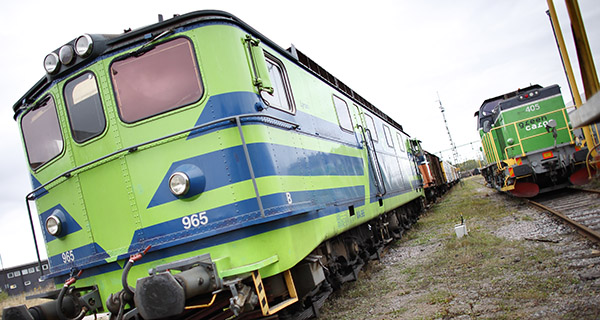Road transport is developing rapidly and its productivity has increased sharply. Rail transport, however, has not developed at the same rate. Automation and digitalisation are essential if rail freight in Europe is to survive.
When a freight train is put together, the coupling of the wagons is often performed manually. Before the train is able to set off, an employee must walk along the entire length of the train, which could be up to 650 metres long, in order to inspect the braking system on the wagons. The technology used on the railways has, in many cases, remained unchanged for several decades. At the same time, freight traffic on our roads is developing rapidly. The vehicles are becoming larger and more efficient and there is a great deal of research and innovation taking place in road and vehicle technologies. The transport costs for goods vehicles have decreased dramatically and will continue to fall. For the sake of the environment, rail transport must move in the same direction.

Automation and digitalisation will make rail competitive. Photo: Hejdlösa Bilder
“Radical changes to rail freight are required; otherwise it will soon be out competed by road haulage”, says Sofia Lundberg, Deputy Research Director at VTI.
The situation can also be described in figures. In the past 20 years, the productivity of road haulage has increased by 50 per cent, while the equivalent figure for rail freight is a modest three per cent. There is a great risk that the imbalance between these types of transport will increase further because research and development focused on road transport is far better resourced than that focused on rail, in particular through actors such as Volvo and Scania, but also through direct and indirect research grants from government ministries.
“This is a development that directly conflicts with the transport policy goals in both Sweden and Europe of reduced fossil emissions”, says Sofia Lundberg.
The major European research programme Shift2Rail has a goal of making rail freight more competitive. This is to be achieved through extensive automation and digitalisation. Development is being worked on within a wide range of areas such as intelligent locomotives and wagons, developed rail freight corridors and larger and heavier trains.
Swedish National Road and Transportation Institute, VTI, has several assignments within the scope of Shift2Rail, including some in the field of automation. A recently completed preliminary study, which was conducted together with KTH and TFK, highlights eight areas of technological development that together would create the conditions for more modern and more efficient rail freight.
Automatic coupling of wagons is one such technology. This is a prerequisite if we are to automate rail freight and would also improve the working environment in marshalling yards.
“We also need to develop intelligent wagons that are able, for example, to read their own and the infrastructure’s permission and signal when it is time for maintenance”, says Sofia Lundberg.
Freight trains that can conduct automated brake tests are another important area and this is what researcher Mattias Hjort from VTI will continue to work on.
The long-term vision is that, by 2030, long, fast, intelligent goods trains will be operating on Europe’s railways, travelling between highly automated freight terminals and marshalling yards. With automated trains, it is possible to operate safely with short distances between the trains and thus increase the capacity of the railways. Perhaps we have also developed technology that allows the trains to split up and connect themselves together while in motion in order to make this a more flexible transport option.
 Contact
Contact
Sofia Lundberg
sofia.lundberg@vti.se
VTI, Sweden






Follow us: